AMD’s FSR 3 technology made a surprise debut earlier this month in two games: Forspoken and Immortals of Aveum, and we’re ready to give you an early look of the technology. There’s a lot to cover in this article including a discussion about frame pacing, image quality and latency.
FidelityFX Super Resolution 3 (FSR 3, for short) is AMD’s answer to Nvidia’s DLSS 3, which introduced frame generation support for RTX 40 series graphics cards about a year ago. The overarching concept is that between each normally rendered frame, frame generation can create an interpolated frame to improve the smoothness of the game’s presentation.
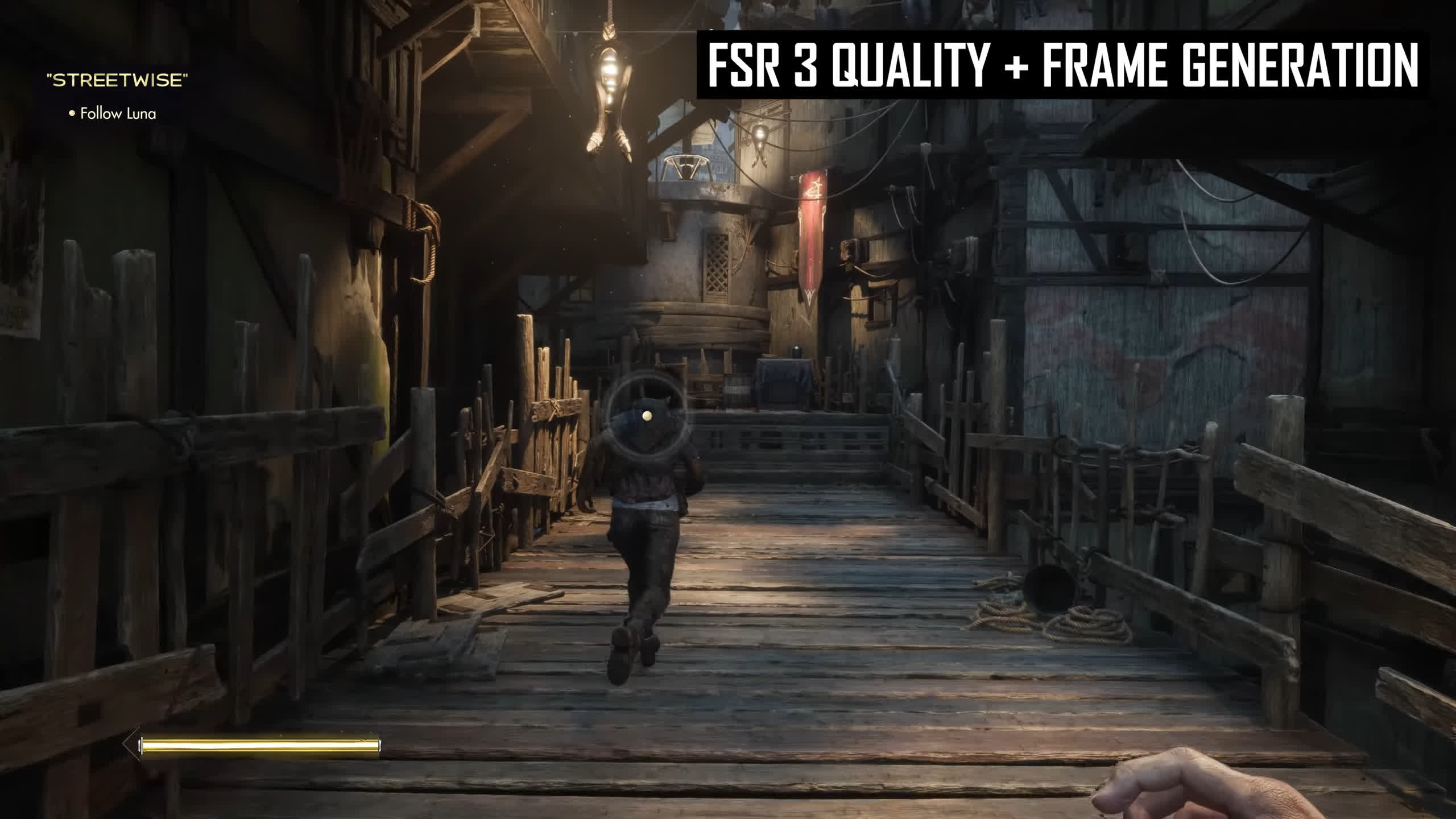
FSR 3 introduces frame generation that’s similar to DLSS 3 in its functionality and goals, with AMD starting to roll out their take on the technology now after announcing it on November 2022.
The main difference between FSR 3 frame generation and DLSS 3 frame generation at a surface level is compatibility. DLSS 3 is exclusive to Nvidia’s RTX 40 graphics cards, with Nvidia claiming that only their Ada Lovelace architecture has the optical flow accelerator performance necessary to drive frame generation.
FSR 3, on the other hand, is available for all graphics cards, with official support for AMD’s Radeon 5000 series and Nvidia’s RTX 20 series and above. AMD is effectively claiming that they have an optical flow frame interpolation system that is performant enough to not require specific hardware accelerators, which certainly disrupts the GPU features race – provided it actually works well.
Recommended hardware for using AMD FSR 3 with upscaling and frame generation
| AMD | Nvidia |
|
Supported: Recommended: |
Supported: Recommended: |
With about a year gap between the launch of the two technologies, currently there’s only two games with FSR 3 frame generation support, Forspoken and Immortals of Aveum. Enabling the feature is as simple as turning on FSR 3 upscaling and then toggling frame generation in the game’s settings.
A slide from AMD’s presentation on FSR 3 and Temporal Upscaling
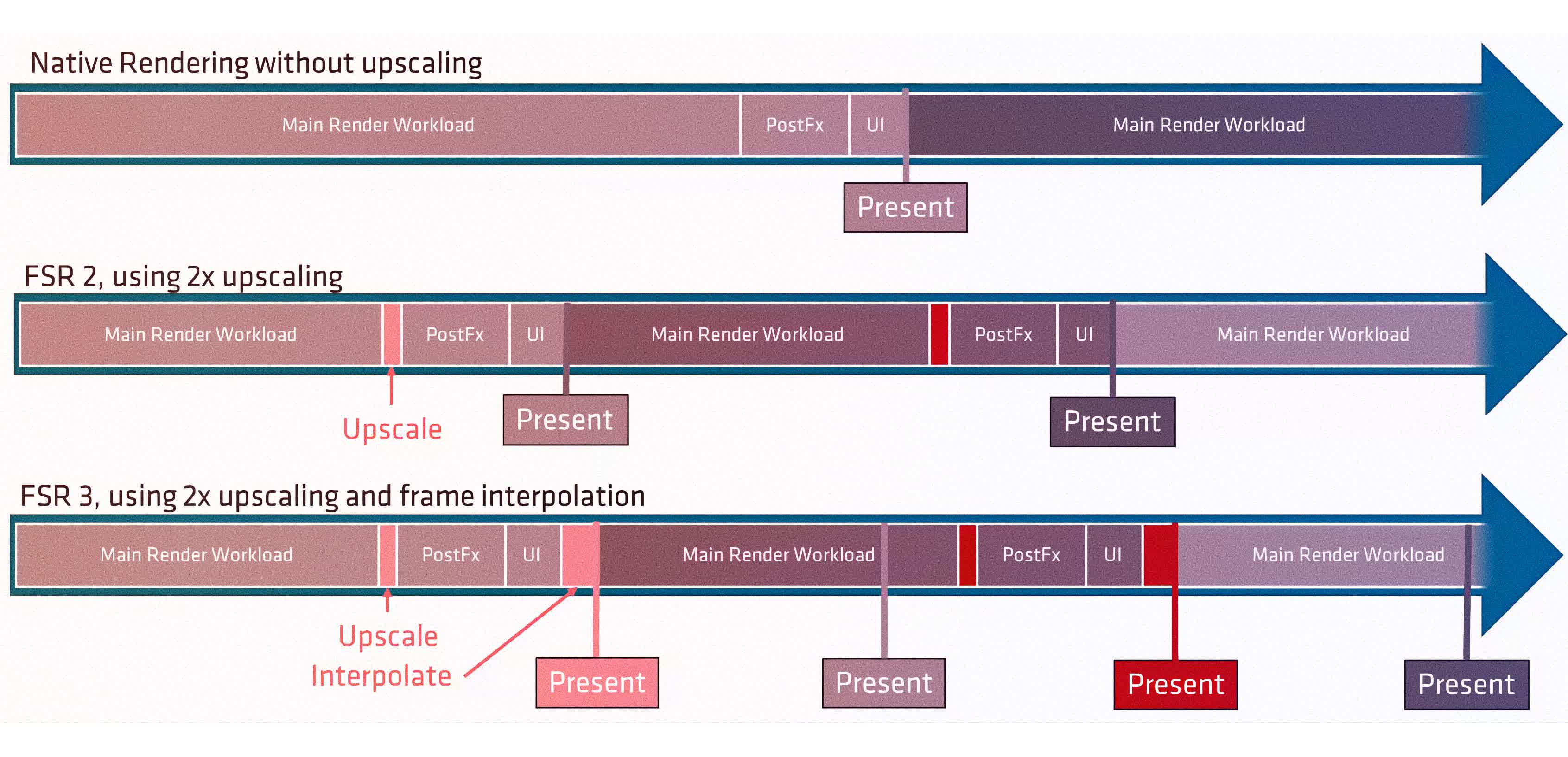
Unlike with DLSS, FSR 3 frame generation requires the use of FSR 3 upscaling, so you are tied to FSR if you want to access AMD’s frame gen tech and it cannot be enabled with native rendering or DLSS upscaling.
FSR 3 also introduces a new native AA mode that applies the temporal anti-aliasing and sharpening component of FSR without upscaling for those looking for better image quality than what FSR usually offers.
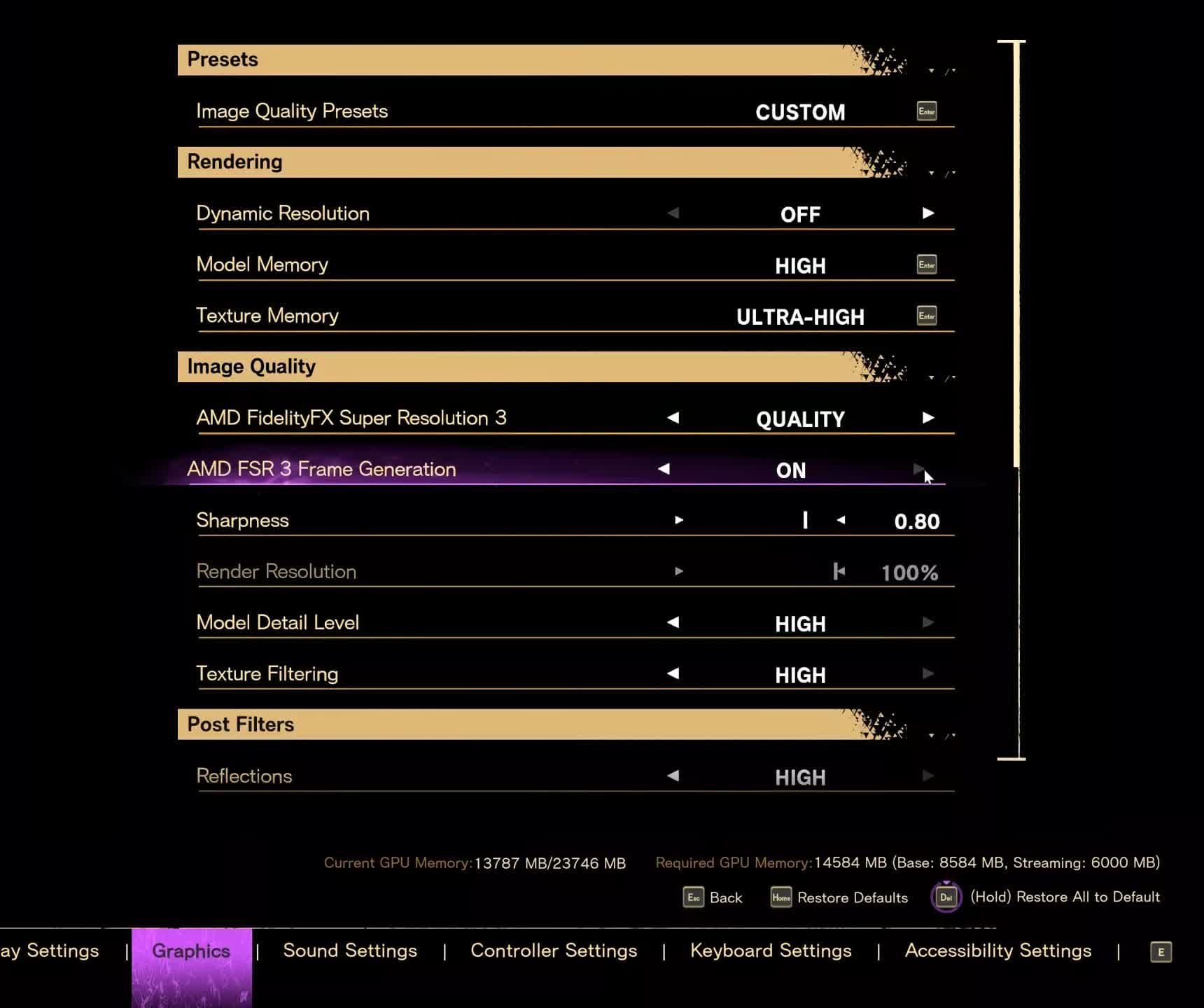
While FSR 3’s game integration is as simple as a toggle, unfortunately it’s not a technology that “just works.” And this is where we need to start talking about FSR 3’s frame pacing and configuration.
FSR 3 Frame Pacing Issues
FSR 3 works differently depending on whether you are using variable refresh rate (VRR) technology or not. It also works differently depending on whether you are gaming with VSync on or off. The exact configuration you are using drastically alters the final FSR 3 output quality and the way it paces frames to your display. Let’s break it all down.
Right now, all VSync off configurations in Forspoken and Immortals of Aveum are fundamentally broken with FSR 3. Frames are not being paced correctly with VSync disabled, leading to either a blurry or juddery presentation (or some combination of both issues).
This means that in a VSync off state, FSR 3 provides zero benefit. While it does increase the frame rate number you’ll see in an FPS counter, the actual visual presentation is no different from using FSR 3 off, and in some cases can be worse.
For a better representation of image quality comparisons, check out the HUB video below:

In the video above is an example of how VSync off with FSR 3 frame generation is pacing frames to the display. You’ll have to excuse the low quality slow motion footage here, we don’t have a particularly great 1000 FPS camera.
Both configurations are running at approximately 100 FPS with VSync off on a variable refresh rate display. However we don’t seem to be getting a true 100 FPS output with frame generation enabled; instead, relative to natively rendered 100 FPS, frame generation appears to be outputting frames at a much lower rate. We believe with VSync off that FSR 3 is not properly pacing or displaying half of the frames to the point where it makes little to no difference compared to not using frame generation and simply playing at a lower frame rate.
AMD tells us that VSync off in both launch titles is using an older method for handling frame generation, older than the version described on their GPUOpen website. We have no idea why an old version of FSR 3 would be used to launch the technology if a fix for VSync off is known and implemented in newer code, but here we are.
FSR 3 frame generation also doesn’t work properly with any variable refresh rate configuration when gaming inside your monitor’s refresh rate range. Normally when gaming with VRR enabled, your frame rate and monitor’s refresh rate are synced to reduce judder and screen tearing from any mismatch. FSR 3 breaks this functionality.
When we view slow motion footage we can confirm this is the case. Without frame generation, a 100 FPS output is consistently paced to the display. With frame generation enabled, the monitor’s refresh rate counter remains mostly at its maximum (in this case 160Hz) with the occasional dip to a lower refresh rate, so the 100 FPS output is not synchronized with the refresh rate. This causes frame pacing judder, and as some frames are being shown on screen for longer than in a VRR state, it can also lead to increased blur in some situations.
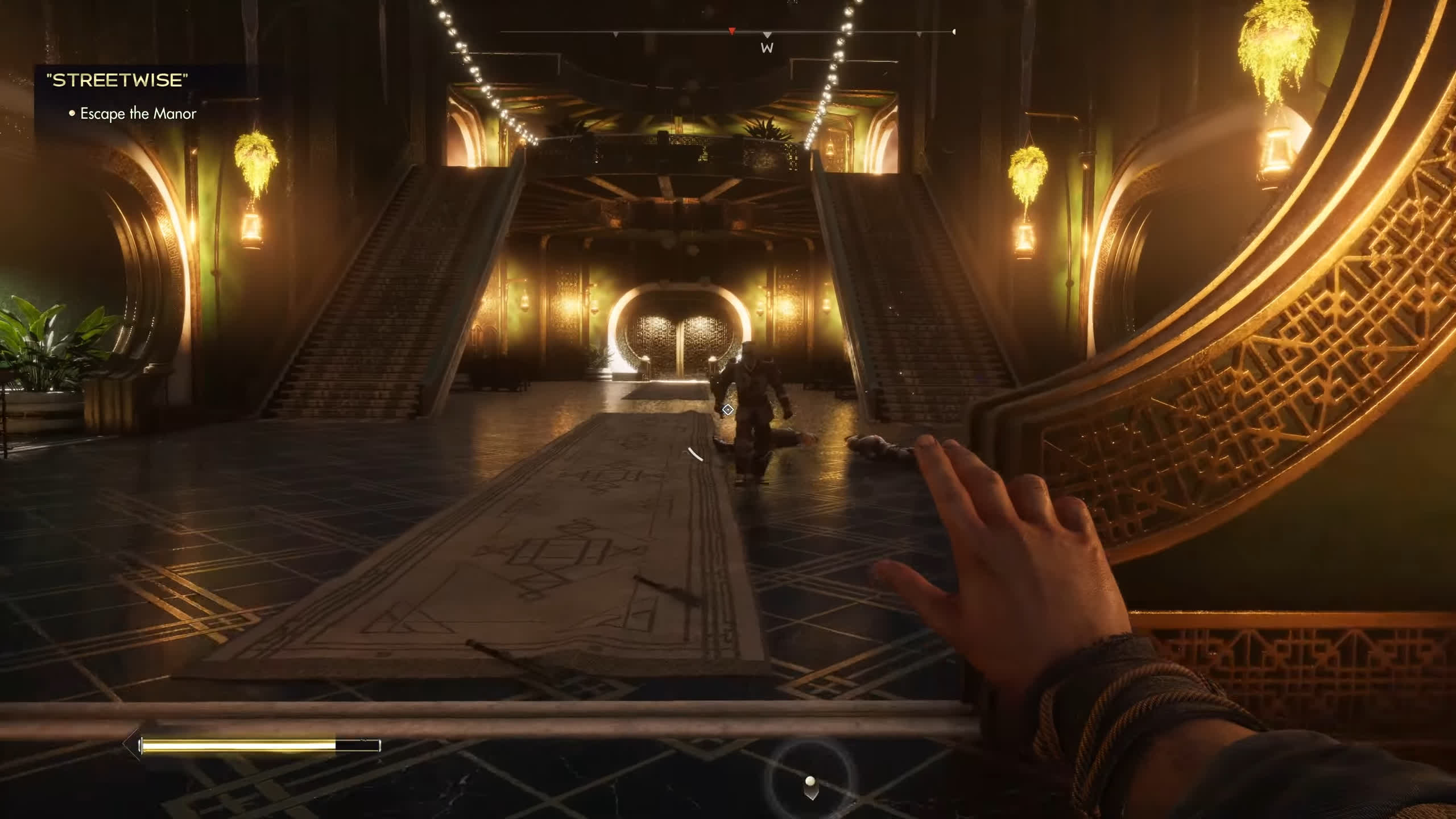
However, when we compare this to DLSS 3, we can see that Nvidia’s frame generation technology is correctly and accurately pacing frames and working just fine with variable refresh rates, as you would expect for a 100 FPS output on a 160Hz monitor. This is true for FSR 3 whether you have an Nvidia or AMD GPU.
This is also true if you use a frame cap inside your monitor’s maximum refresh rate. Native rendering with a 120 FPS cap will switch your VRR capable monitor to run at 120Hz. With FSR 3 frame generation, capping to 120 FPS will still make your monitor run at the maximum refresh rate, in this case 160Hz, which is a mismatch that causes judder – even though the frame time output graph appears smoother. The only time we saw correct frame pacing was when frame generation was able to max out the monitor’s refresh rate.
In practice this limits the benefit of FSR 3. The larger the gap in output frame rate and monitor refresh rate, the more juddery and unpleasant the FSR 3 experience is. While this does work better than VSync off and the actual number of delivered frames is higher than not using frame generation, depending on how low the frame rate is, FSR 3 can actually feel less smooth, which defeats the whole purpose of the technology.
These issues are minimized at higher frame rates and a closer gap to your monitor’s max refresh rate. In our configuration, for example, anything above 130 FPS on my 160 Hz monitor felt quite good and looked clearer than not using frame generation and therefore playing at a lower frame rate. The ideal experience occurs when running at the max refresh rate, but just a little under that still worked well.
We found a small improvement when disabling variable refresh rates and running at a fixed refresh with VSync on. My monitor’s refresh rate became less erratic, which helped pace frames a little better, but ultimately if you are running FSR 3 below your monitor’s max refresh rate in this state, there is still a chance of judder as we know is the case for fixed refresh gaming. The same applies as described before, where anything above 130 FPS on my 160Hz monitor felt pretty good, but below that and especially below 100 FPS the judder was very noticeable and not ideal.
With such a strong focus on VSync on gaming and maxing out your refresh rate, we believe AMD hasn’t tested variable refresh rate configurations adequately enough, and hasn’t optimized the experience for what we’d say is the most common and desirable configuration that include variable refresh rate.
In response, AMD tells us that FSR 3 was designed for use with VSync on with the goal of maxing out your monitor’s refresh rate. They also told us they had frame pacing working correctly with variable refresh rates in their labs, something we were unable to replicate on either Nvidia or AMD GPUs. My experience seems to align with other people testing FSR 3 frame generation.
With such a strong focus on VSync on gaming and maxing out your refresh rate, we believe AMD hasn’t tested variable refresh rate configurations adequately enough, and hasn’t optimized the experience for what we’d say is the most common and desirable configuration that includes variable refresh rate.
Pretty much every gaming monitor sold in the last 5-7 years supports it, so having to disable VRR or tune settings to max out your monitor’s refresh rate feels like an old school approach in a world with widespread variable refresh, sometimes with very high max refreshes like 240Hz or even 540 Hz these days.
FSR 3 Image Quality vs DLSS 3
At this point it becomes obvious that FSR 3 doesn’t run as well as DLSS 3 in its current state as the latter does support variable refresh rates, VSync on, and VSync off. With DLSS 3 frame generation, you can use any configuration you like, turn on the frame generation toggle and experience properly paced interpolated frames.
For a better representation of image quality comparisons, check out the HUB video below:

With FSR 3 frame generation you have to ensure your output frame rate is high enough, probably disable variable refresh rates, and make sure VSync is on. That’s too much fiddling around when the direct alternative and competitor technology effectively “just works.”
Now let’s talk about the actual quality of FSR 3 frame generation when used in an ideal configuration: maxing out your monitor’s refresh rate. The quality of interpolated / generated frames is probably the biggest strength of FSR 3 right now and one aspect that AMD have largely gotten right.
The biggest win for FSR 3 frame generation is how FSR handles UI elements. DLSS 3 struggles with this, and while it has improved since launch, there are still titles that don’t have perfect handling of UI elements, often featuring garbled, distracting, awful UI in motion. This was by far the most noticeable issue from Nvidia’s frame generation. With FSR 3, we didn’t spot any UI issues testing Forspoken or Immortals of Aveum. Both games with FSR 3 frame generation handle the UI flawlessly, no garbling, no distracting issues, which eliminates the biggest artifact seen from this technology.
For a better representation of image quality comparisons, check out the HUB video below:

Even in a title like Immortals of Aveum which generally has good UI rendering from both FSR 3 and DLSS 3, FSR 3 has the edge. When we look at semi-transparent UI elements, for example, FSR 3 better handles interpolation behind the transparency in motion compared to DLSS 3. This is because FSR 3 has a mode for game developers that fully decouples the UI loop from the frame generation loop. We suspect this is how most games will handle the UI with FSR 3, although AMD did mention there is an option game developers can use to put the UI through the interpolation pass, something I hope is not used if it creates significant artifacting.
Like with DLSS 3, it’s hard to spot any artifacts from the FSR 3 generated frames themselves when the final output frame rate is in the 100 to 120 FPS range or higher – which typically corresponds to a native 60 FPS render rate or higher. While the issues are evident when slowing down the footage and inspecting frame by frame, having these lower quality frames interspersed with higher quality frames significantly reduces their visibility and how noticeable these artifacts are. The higher the frame rate, the shorter each of these frames is being shown.
And pretty much identically to DLSS 3, FSR 3 frame generation falls apart when used at a low native render rate, especially when taking 30-40 FPS and turning it into 60-70 FPS. This is not a recommended use case for frame generation, it just doesn’t work well, artifacts in motion are quite noticeable and this substantially reduces visual quality. Having a relatively high output frame rate is key to ensuring all frame generation tech works well.
Having a relatively high output frame rate is key to ensuring all frame generation tech works well.
When more closely assessing the quality of FSR 3 generated frames, we would say their quality is not quite as good as DLSS 3 generated frames, although in practice at a high enough frame rate it’s difficult to tell the difference.
For a better representation of image quality comparisons, check out the HUB video below:

Typical pain points for frame generation are any fine details, like wires or chains. When slowed down (as shown in the video) you’ll see that every second frame has garbled chain detail for both DLSS and FSR frame generation, although DLSS ends up less garbled. Transparency effects trip up frame generation, with FSR 3 again looking a bit blurrier in its generated frames for this magical white effect.
Fast complex motion can cause interpolation issues as well. When changing your weapon in Aveum, both DLSS 3 and FSR 3 produce a lot of garbling as each frame struggles to deal with the rapid changes in motion. However on close inspection the level of garbling is greater on the FSR 3 side, though neither tech could be described as generating high quality frames in this situation.
In many other situations you’ll see similar output from DLSS 3 and FSR 3 frame generation, at least based on the current sample of one that we have. For example, simple motion like camera pans or translation generally works well, with both technologies relying on motion vectors to deliver the same level of detail as in ‘real’ frames. More complex textures and elements like foliage can have issues during simple motion, but we didn’t see a clear winner for this between DLSS and FSR. We suspect like a lot of other implementations of DLSS and FSR, that these quality battles will vary from game to game.
While artifacts can be hard to spot with a high enough frame rate, it’s pretty clear across both FSR 3 games that generated frames are not equivalent to normally rendered frames in quality. Using either DLSS or FSR without frame generation ensures the least amount of artifacting, but with frame generation on, it’s rare to get the “perfect” generated frame. When enabling FSR 3 you’ll have to accept that the resulting image quality from each frame is reduced to improve the smoothness of the presentation, with a lower quality output compared to rendering the game natively at the same frame rate.
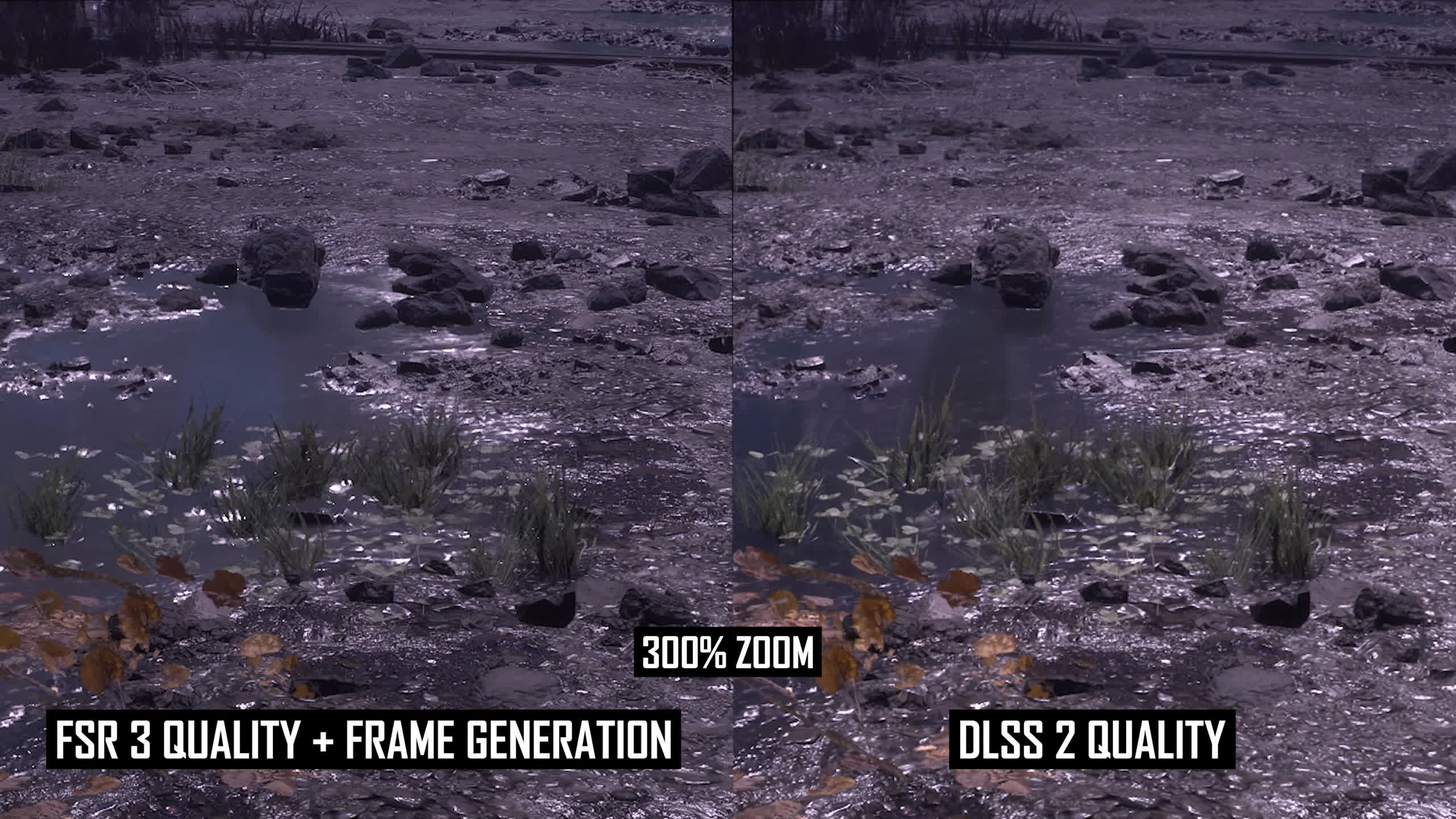
But the biggest issue with FSR 3 image quality is not the generated frames themselves, it’s the quality of FSR upscaling, which AMD tells us has only received minor improvements (if any) relative to FSR 2.2.
This means that in a battle between FSR 3 and DLSS 3 frame generation, DLSS typically has noticeably superior image quality – and that’s down to DLSS having better upscaled image quality, which will dictate the quality of the “real” frames that are shown and input into the interpolation algorithm. So while the difference in generated frame quality isn’t all that noticeable at a high frame rate, the overall difference in image quality from upscaling certainly is.
For a better representation of image quality comparisons, check out the HUB video below:

Even at a 4K resolution, which we used for all image quality comparisons in the videos, in both Forspoken and Immortals of Aveum, DLSS upscaling is superior to FSR upscaling and that impacts the visual presentation for frame generation. In particular, DLSS has greater image stability and less shimmering, as well as occasionally better fine detail reconstruction in motion.
Even when pitting DLSS Quality mode up against FSR Native AA upscaling, DLSS Quality was better in both titles evaluated, it simply has better image stability in motion which is noticeable as both games are heavy on foliage and particle effects. While we didn’t extensively test this, we expect the gap to widen as it typically does when testing lower render resolutions or lower output resolutions.
This ends up as the defining difference in image quality between the two techniques. As FSR 3 frame generation requires the use of FSR upscaling, you are locked into using that upscaling even if a higher quality technology is available. In a head to head battle with DLSS 3 frame generation using DLSS upscaling, FSR 3 has lower overall image quality because of this even though we were okay with the quality of FSR 3 generated frames. Until AMD can improve the quality of their upscaling component, this gap between AMD and Nvidia tech will remain.
For a better representation of image quality comparisons, check out the HUB video below:

The forced use of FSR upscaling with FSR 3 frame generation also locks out potentially superior combinations. For example, Nvidia RTX 30 series owners would have a better experience using DLSS upscaling with FSR frame generation, as they can’t access DLSS frame generation but can use DLSS upscaling.
We imagine AMD doesn’t want to give Nvidia owners the best experience with FSR frame generation, hence the reason for locking it to FSR upscaling for feature parity across Radeon and GeForce GPUs. But this does end up hurting Radeon owners, too, because a game like Forspoken looks better with native TAA than using FSR upscaling or even the FSR Native AA mode. Having access to native rendering + frame generation, or DLSS + FSR frame generation, or even XeSS + FSR 3, would be ideal.
FSR 3 Latency and Performance
Finally, let’s talk about latency and FPS output performance. On a Radeon RX 7900 XTX, FSR 3 is quite effective at increasing the output FPS. When using the Native AA mode in the scene we tested in Immortals of Aveum, we went from 43 FPS to 79 FPS, an 83% increase.

At the same time, latency decreased due to AMD’s built-in latency reducing tech that is applied when frame generation is enabled. So with FSR 3 on, we ended up seeing a 23ms drop to latency, noting that the muzzle flash we were testing in Aveum isn’t instant on mouse click hence the high overall numbers.
Using Quality upscaling instead, we saw frame generation increase FPS from 71 to 122, a 72 percent increase. Latency in this configuration dropped by 8ms. However the lowest latency mode here was still rendering at a higher native frame rate, FSR with Performance mode upscaling delivered 91 FPS – lower than FSR 3 Quality with frame generation – but it had around 10ms less latency.

One interesting discovery is that for compatible Radeon GPUs, currently Anti-Lag+ doesn’t impact latency to any significant degree with FSR 3 enabled. While Anti-Lag+ does have a big impact for non frame gen configurations, cutting FSR Quality mode latency by 33ms at the same frame rate, this doesn’t apply to frame generation. AMD confirmed these findings, noting that right now Anti-Lag+ is ineffective in the two FSR 3 launch titles and the driver-side feature and its corresponding profiles for these games needs more work to properly detect FSR 3 frame generation output.

On a GeForce RTX 4090, there was no latency improvement between frame generation on or off. When using FSR 3 Quality we saw around 105ms of latency at 84 FPS in the scene tested, and with frame generation that improved to 140 FPS with 108ms of latency. The RTX 4090 didn’t benefit quite as much from FSR 3 frame generation as the Radeon 7900 XTX did, though the margins between them in terms of percentage uplift weren’t massive.
A lot of AMD’s marketing has focused on FSR 3 providing both a higher frame rate and lower latency than native rendering, which are the same claims that Nvidia makes for DLSS 3 frame generation. However, what we’ve seen is that the majority of this latency benefit is from also applying upscaling, not from the frame generation component itself which doesn’t improve latency to the same degree as running at a higher native render rate. We therefore end up with the same situation as DLSS frame generation, where it does improve the smoothness of the presentation, but doesn’t feel as responsive as true higher frame rate gaming.

The real kicker for FSR 3 latency is that Nvidia’s current DLSS 3 implementation delivers notably lower latency due to its full integration with Reflex. On a GeForce RTX 4090, Reflex provides a solid latency improvement: when using DLSS Quality upscaling and no frame generation, Reflex itself reduces latency from 106 to 87ms. This is a similar benefit we saw from Anti-Lag+ on the Radeon side, where we went from 122 to 89ms of latency under similar conditions.
But as Reflex works and is always enabled with DLSS 3 frame generation, in our testing we saw an output frame rate of 125 FPS for 90ms of latency using Quality upscaling. FSR 3, without Reflex, delivered 140 FPS for 108ms of latency. So while FSR frame generation was able to increase the frame rate by 67%, versus just a 42% increase for DLSS frame generation, DLSS ended up with 18ms lower latency.

This is where the lack of compatibility for FSR 3 with Anti-Lag+ hurts. The RTX 4090 using Nvidia frame generation tech and Reflex delivered 125 FPS and 90ms of latency. The RX 7900 XTX using AMD frame generation tech and Anti-Lag+ delivered 124 FPS with 107ms of latency. In a best vs. best comparison that gives Nvidia the latency edge, until AMD can get Anti-Lag+ working effectively. And given that you can use Reflex on an Nvidia GPU alongside FSR 3, currently the lowest latency experiences with FSR 3 technology will be on an Nvidia GPU where that tech is integrated.
It’s not all bad news though. These performance figures do suggest that the optical flow pass in FSR 3 has less overhead than the optical flow pass in DLSS 3, meaning that FSR 3 delivers a higher FPS boost from the same base frame rate. But until latency is equalized this doesn’t result in a better experience from FSR – and won’t until upscaling image quality is improved either.
Bottom Line
Overall, we are not impressed with what we’ve seen from AMD’s FSR 3 so far. The feature seems rushed, incomplete, and not fully ready for prime time. There are too many incompatibilities and configuration issues, which stand out badly compared to Nvidia’s DLSS 3, itself a feature with issues. The resulting FSR 3 frame generation experience is difficult to recommend outside a few niche use cases.
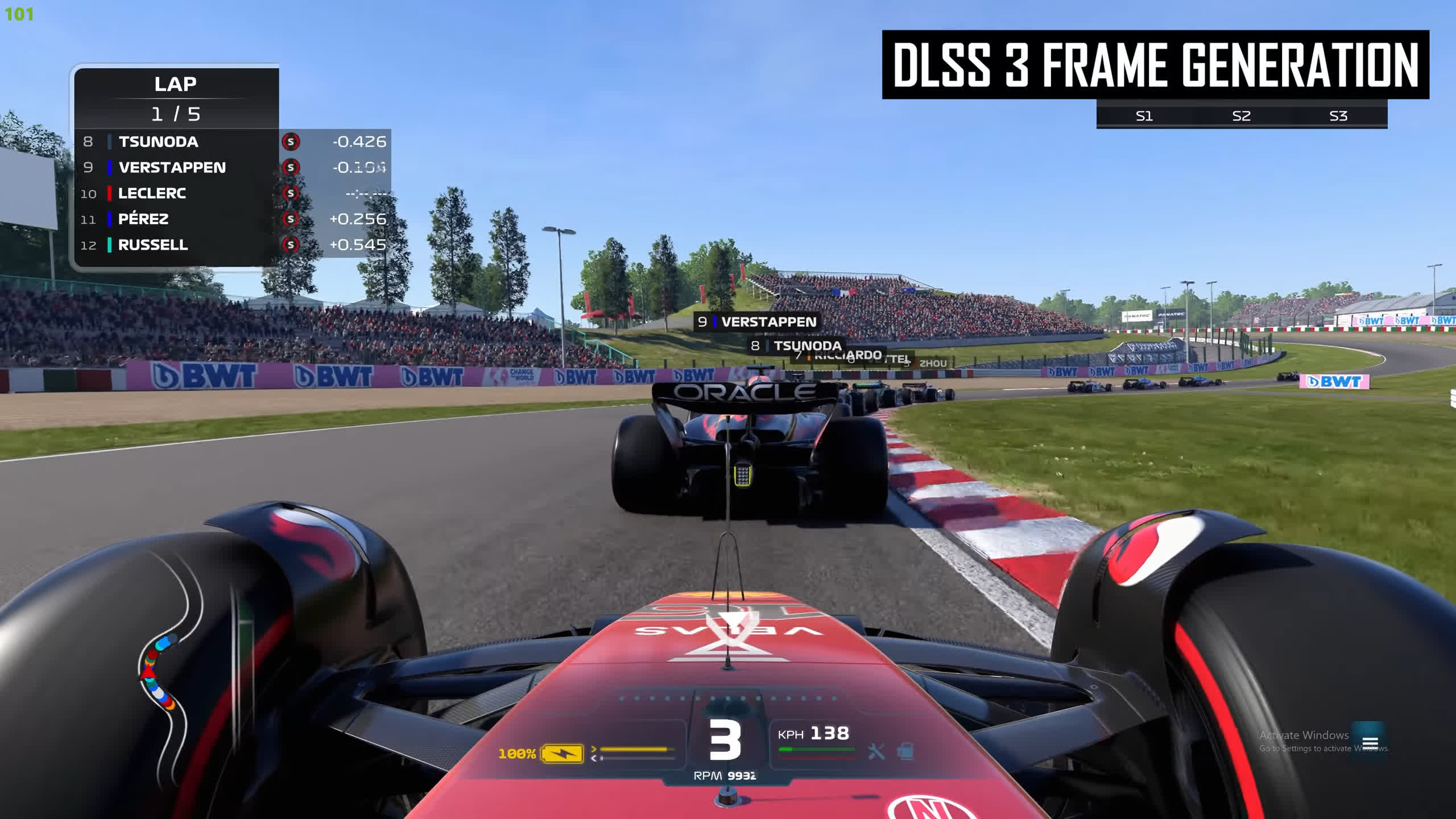
The same sort of caveats that we talked about with DLSS 3 also apply to FSR 3: to avoid visible artifacts in generated frames, you’ll need a base frame rate of at least 60 FPS with a final output around 100 to 120 FPS. And given that frame generation does not improve latency, for that true high refresh rate experience, you’ll want a base frame rate of 100 to 120 FPS (with a final output above 200 FPS) for the responsiveness we typically associate with the best gaming experiences.
This is why we refer to frame generation as a feature that enhances the game’s smoothness, rather than something that improves overall performance – the benefits are entirely visual in nature.
To be entirely clear:
- If you’re a gamer that doesn’t have the GPU performance to hit 60+ base frame rate targets, then frame generation – DLSS 3 or FSR 3 – isn’t going to deliver a very good experience.
- If you’re a gamer that is only playing at 60 FPS but wants to improve that to a true high refresh rate experience, frame generation isn’t properly capable of that.
- If you’re a multiplayer gamer that specifically wants to increase frame rates to access lower latencies and increase responsiveness to make you more competitive, frame generation is useless for that.
FSR 3 is no better than DLSS 3 at any of those aspects that, right now, are fundamental to frame generation. Where AMD stumbles is they’ve taken a feature that already has somewhat limited usability and limited it further. Not only do you now need to worry about base frame rate, but you’ll also have to ensure you’ve set up VSync correctly and are pumping out enough frames to avoid judder.
This is why we refer to frame generation as a feature that enhances the game’s smoothness, rather than something that improves overall performance – the benefits are entirely visual in nature.
You’ll have to be satisfied with sacrificing proper variable refresh rate functionality – a feature we strongly recommend every gamer uses – to access frame generation. There are situations where that trade off alone is not worth it, as FSR 3 can be less smooth than not using it, defeating the whole purpose of a technology designed to improve smoothness.
That’s not to say FSR 3 never works well.
If you have a reasonably high output frame rate, and are running at or near your monitor’s maximum refresh rate with VSync on, the FSR 3 frame generation experience can be smoother and better than not using frame generation. But when we have DLSS 3 frame generation that – to use an Nvidia-ism “just works” with features like VRR – going backwards on compatibility with FSR 3 really stands out.
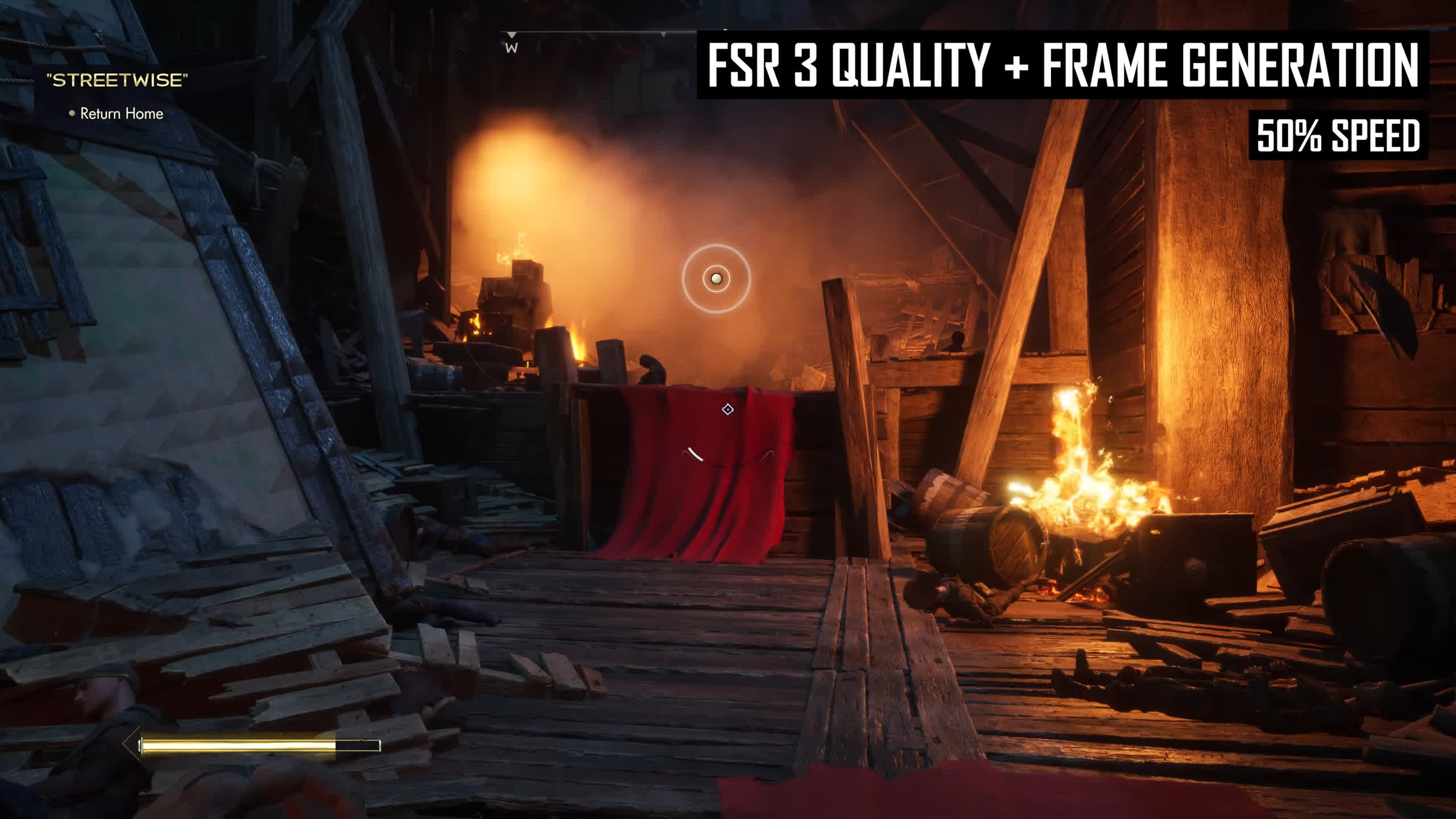
AMD has clearly put a lot of work into ensuring the frame generation part of the technology works well, with fast and effective interpolation. It has lower overhead than DLSS 3 frame generation, it has zero issues rendering UI that we’ve seen so far, the general quality of interpolated frames is acceptable, and it works across all graphics cards – no special hardware required. That’s a win for FSR 3, and it’s the most impressive aspect of what AMD has produced and does provide a solid foundation for improvement.
But all that great work that’s been put into generating frames is let down by AMD’s inferior upscaling technology, which you are locked into using with FSR 3 frame generation. The overall image quality – factoring in generated frames and normal frames – is simply better from DLSS 3 and that’s largely down to Nvidia’s upscaler. Without substantial improvement to FSR upscaling, especially at lower resolutions, DLSS 3 will continue to offer a better overall package than FSR 3.
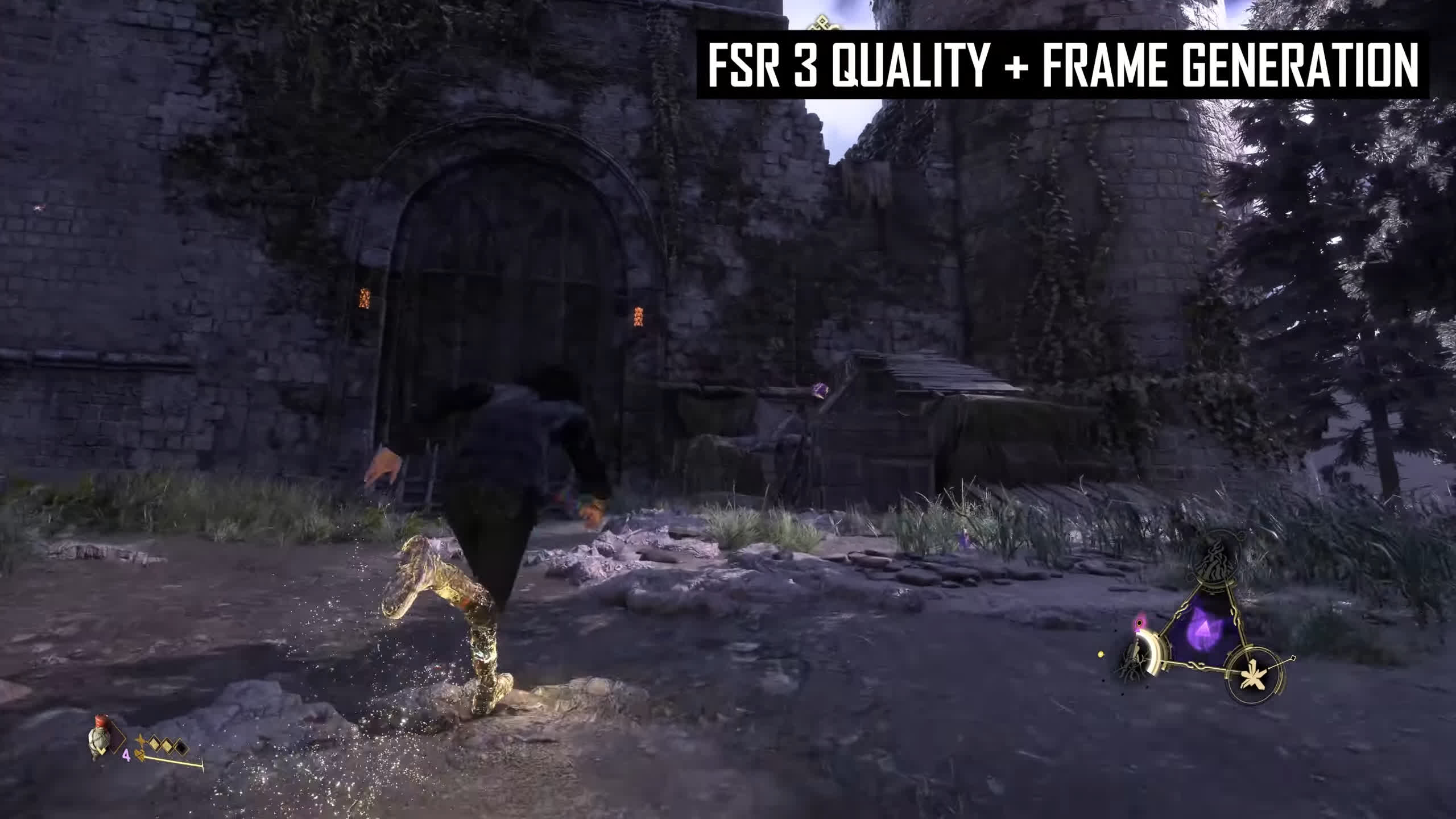
FSR 3 is also let down on the latency front with its incompatibility with Anti-Lag+ at the moment, meaning that DLSS 3 on an Nvidia GPU delivers lower latency at the same output frame rate than FSR 3 on an AMD GPU. The gulf widens for Radeon RX 6000 series which can’t even use Anti-Lag+ at all, and owners of older Nvidia GPUs will be praying for Reflex in FSR 3 titles as the built-in latency reducing tech in FSR 3 isn’t overly effective.
AMD says that some of these issues will be improved. They’re working on Anti-Lag+ compatibility, VSync off has been fixed in a newer version of FSR 3, and they’re aware of VRR compatibility issues. But some of these should have been resolved before launch, so that everyone that turns it on is treated to a great experience. Instead, it seems that AMD rushed this out to make a September launch deadline, alleviating pressure that was put on themselves by announcing FSR 3 far too early.
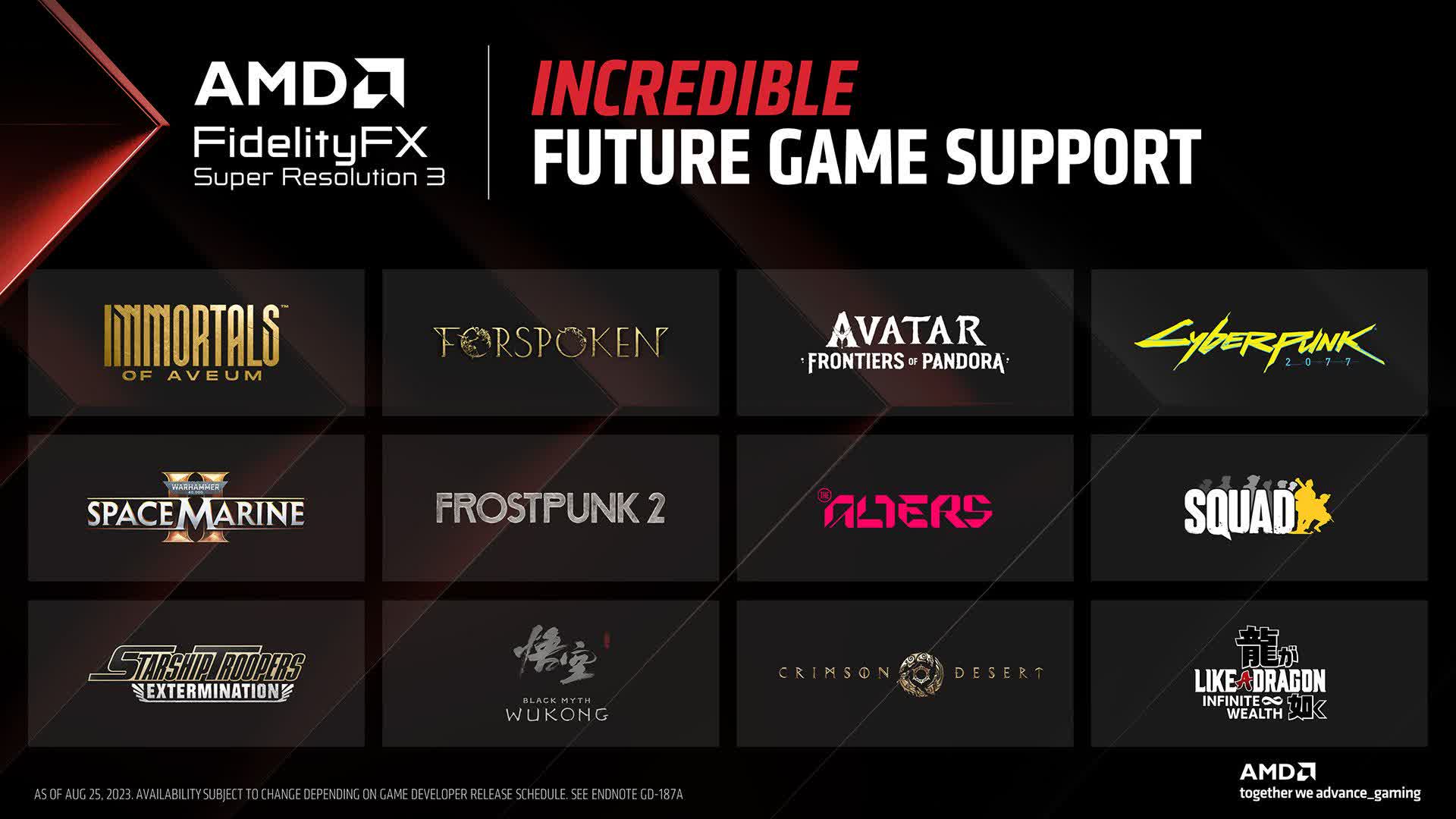
We can only evaluate FSR 3 on what’s in front of us right now, which is integration into two games with plenty of issues. If you can use FSR 3 to max out your monitor, we think the experience will be pretty good for you and we’d probably recommend giving it a try. If that’s not possible, it’s hard to justify using right now.
And that’s really the present state of FSR 3. It isn’t overly competitive with DLSS 3, and it doesn’t do much to close the feature gap between AMD and Nvidia, even if we ignore the large difference in the number of supported titles. If AMD can allocate resources to improve FSR 3, it should be possible to get it to that level we want though. Solve the frame pacing and VRR compatibility issues, get it working with Anti-Lag+ and – perhaps the most difficult of all – improve the quality of FSR upscaling and FSR 3 would be the gold standard for frame generation technology given its low overhead and broad compatibility.
Shopping Shortcuts:
- AMD Radeon RX 7800 XT on Amazon
- AMD Radeon RX 7900 XT on Amazon
- Nvidia GeForce RTX 4060 Ti on Amazon
- Nvidia GeForce RTX 4070 Ti on Amazon
- AMD Radeon RX 7600 on Amazon
- AMD Radeon RX 7900 XTX on Amazon
- Nvidia GeForce RTX 4090 on Amazon